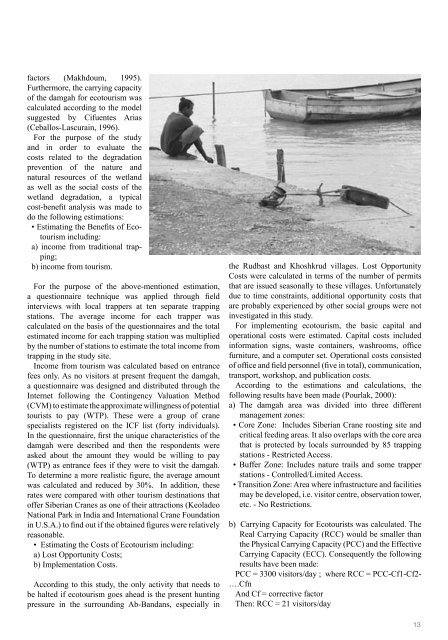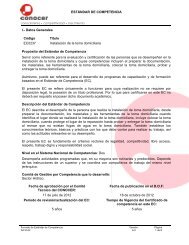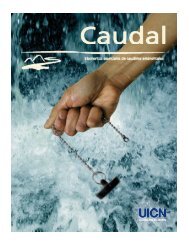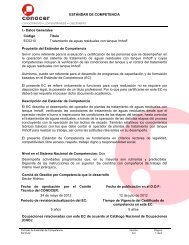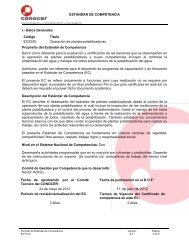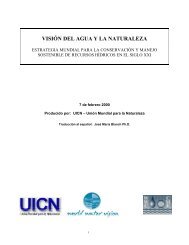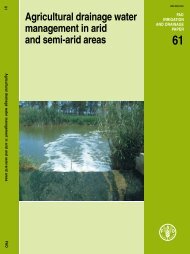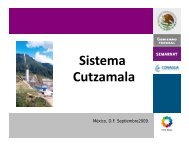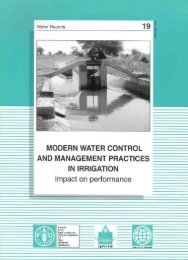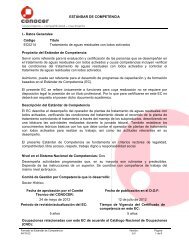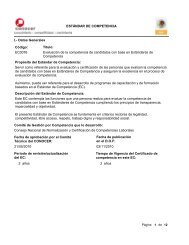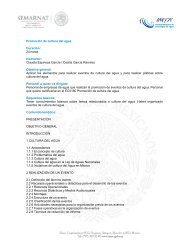The Conservation and Sustainable Use of Freshwater ... - IUCN
The Conservation and Sustainable Use of Freshwater ... - IUCN
The Conservation and Sustainable Use of Freshwater ... - IUCN
You also want an ePaper? Increase the reach of your titles
YUMPU automatically turns print PDFs into web optimized ePapers that Google loves.
factors (Makhdoum, 1995).<br />
Furthermore, the carrying capacity<br />
<strong>of</strong> the damgah for ecotourism was<br />
calculated according to the model<br />
suggested by Cifuentes Arias<br />
(Ceballos-Lascurain, 1996).<br />
For the purpose <strong>of</strong> the study<br />
<strong>and</strong> in order to evaluate the<br />
costs related to the degradation<br />
prevention <strong>of</strong> the nature <strong>and</strong><br />
natural resources <strong>of</strong> the wetl<strong>and</strong><br />
as well as the social costs <strong>of</strong> the<br />
wetl<strong>and</strong> degradation, a typical<br />
cost-benefit analysis was made to<br />
do the following estimations:<br />
• Estimating the Benefits <strong>of</strong> Ecotourism<br />
including:<br />
a) income from traditional trapping;<br />
b) income from tourism.<br />
For the purpose <strong>of</strong> the above-mentioned estimation,<br />
a questionnaire technique was applied through field<br />
interviews with local trappers at ten separate trapping<br />
stations. <strong>The</strong> average income for each trapper was<br />
calculated on the basis <strong>of</strong> the questionnaires <strong>and</strong> the total<br />
estimated income for each trapping station was multiplied<br />
by the number <strong>of</strong> stations to estimate the total income from<br />
trapping in the study site.<br />
Income from tourism was calculated based on entrance<br />
fees only. As no visitors at present frequent the damgah,<br />
a questionnaire was designed <strong>and</strong> distributed through the<br />
Internet following the Contingency Valuation Method<br />
(CVM) to estimate the approximate willingness <strong>of</strong> potential<br />
tourists to pay (WTP). <strong>The</strong>se were a group <strong>of</strong> crane<br />
specialists registered on the ICF list (forty individuals).<br />
In the questionnaire, first the unique characteristics <strong>of</strong> the<br />
damgah were described <strong>and</strong> then the respondents were<br />
asked about the amount they would be willing to pay<br />
(WTP) as entrance fees if they were to visit the damgah.<br />
To determine a more realistic figure, the average amount<br />
was calculated <strong>and</strong> reduced by 30%. In addition, these<br />
rates were compared with other tourism destinations that<br />
<strong>of</strong>fer Siberian Cranes as one <strong>of</strong> their attractions (Keoladeo<br />
National Park in India <strong>and</strong> International Crane Foundation<br />
in U.S.A.) to find out if the obtained figures were relatively<br />
reasonable.<br />
• Estimating the Costs <strong>of</strong> Ecotourism including:<br />
a) Lost Opportunity Costs;<br />
b) Implementation Costs.<br />
According to this study, the only activity that needs to<br />
be halted if ecotourism goes ahead is the present hunting<br />
pressure in the surrounding Ab-B<strong>and</strong>ans, especially in<br />
the Rudbast <strong>and</strong> Khoshkrud villages. Lost Opportunity<br />
Costs were calculated in terms <strong>of</strong> the number <strong>of</strong> permits<br />
that are issued seasonally to these villages. Unfortunately<br />
due to time constraints, additional opportunity costs that<br />
are probably experienced by other social groups were not<br />
investigated in this study.<br />
For implementing ecotourism, the basic capital <strong>and</strong><br />
operational costs were estimated. Capital costs included<br />
information signs, waste containers, washrooms, <strong>of</strong>fice<br />
furniture, <strong>and</strong> a computer set. Operational costs consisted<br />
<strong>of</strong> <strong>of</strong>fice <strong>and</strong> field personnel (five in total), communication,<br />
transport, workshop, <strong>and</strong> publication costs.<br />
According to the estimations <strong>and</strong> calculations, the<br />
following results have been made (Pourlak, 2000):<br />
a) <strong>The</strong> damgah area was divided into three different<br />
management zones:<br />
• Core Zone: Includes Siberian Crane roosting site <strong>and</strong><br />
critical feeding areas. It also overlaps with the core area<br />
that is protected by locals surrounded by 85 trapping<br />
stations - Restricted Access.<br />
• Buffer Zone: Includes nature trails <strong>and</strong> some trapper<br />
stations - Controlled/Limited Access.<br />
• Transition Zone: Area where infrastructure <strong>and</strong> facilities<br />
may be developed, i.e. visitor centre, observation tower,<br />
etc. - No Restrictions.<br />
b) Carrying Capacity for Ecotourists was calculated. <strong>The</strong><br />
Real Carrying Capacity (RCC) would be smaller than<br />
the Physical Carrying Capacity (PCC) <strong>and</strong> the Effective<br />
Carrying Capacity (ECC). Consequently the following<br />
results have been made:<br />
PCC = 3300 visitors/day ; where RCC = PCC-Cf1-Cf2-<br />
….Cfn<br />
And Cf = corrective factor<br />
<strong>The</strong>n: RCC = 21 visitors/day<br />
13


